tire type FORD ECOSPORT 2022 Warranty Guide
[x] Cancel search | Manufacturer: FORD, Model Year: 2022, Model line: ECOSPORT, Model: FORD ECOSPORT 2022Pages: 73, PDF Size: 3.06 MB
Page 7 of 73
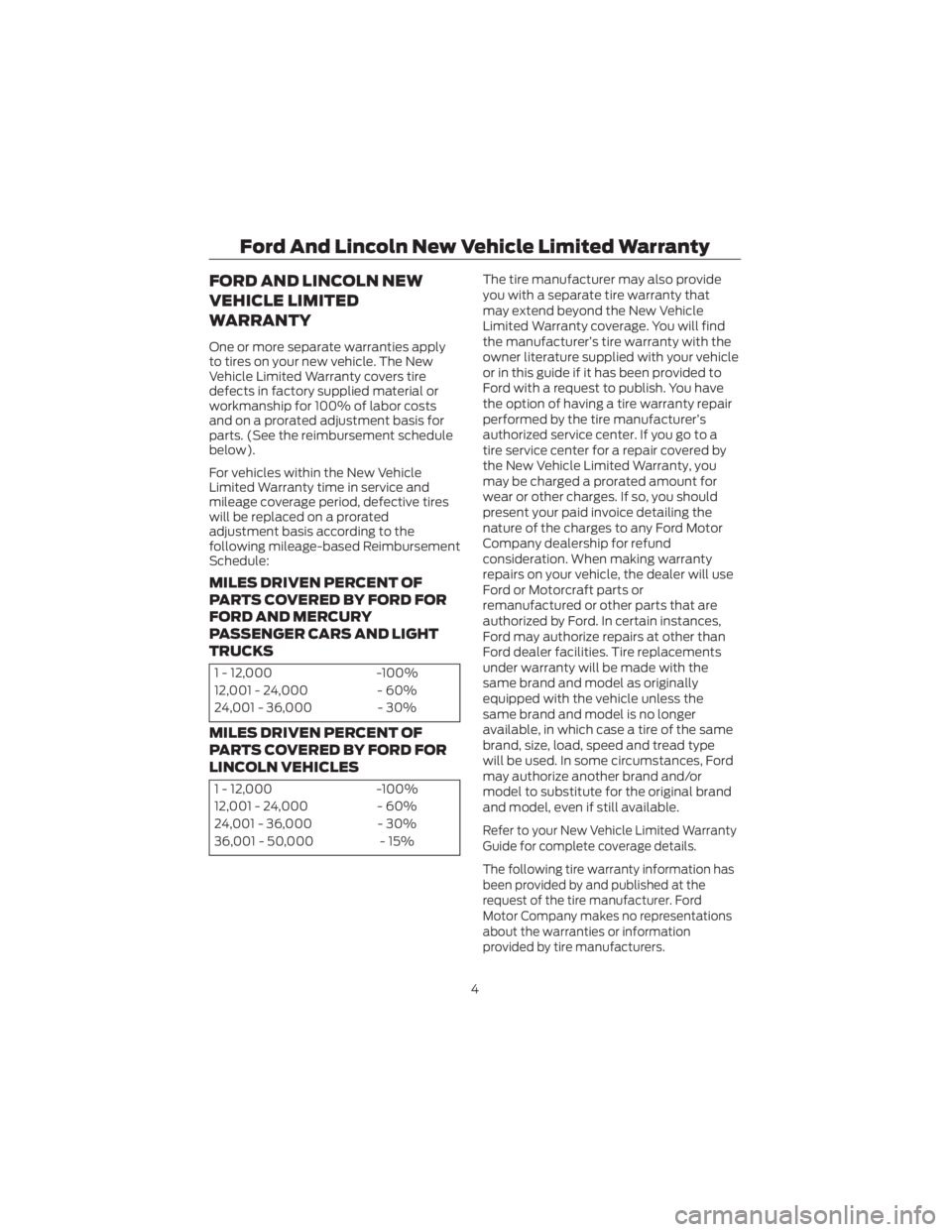
FORD AND LINCOLN NEW
VEHICLE LIMITED
WARRANTY
One or more separate warranties apply
to tires on your new vehicle. The New
Vehicle Limited Warranty covers tire
defects in factory supplied material or
workmanship for 100% of labor costs
and on a prorated adjustment basis for
parts. (See the reimbursement schedule
below).
For vehicles within the New Vehicle
Limited Warranty time in service and
mileage coverage period, defective tires
will be replaced on a prorated
adjustment basis according to the
following mileage-based Reimbursement
Schedule:
MILES DRIVEN PERCENT OF
PARTS COVERED BY FORD FOR
FORD AND MERCURY
PASSENGER CARS AND LIGHT
TRUCKS
1 - 12,000-100%
12,001 - 24,000 - 60%
24,001 - 36,000 - 30%
MILES DRIVEN PERCENT OF
PARTS COVERED BY FORD FOR
LINCOLN VEHICLES
1 - 12,000-100%
12,001 - 24,000 - 60%
24,001 - 36,000 - 30%
36,001 - 50,000 - 15%The tire manufacturer may also provide
you with a separate tire warranty that
may extend beyond the New Vehicle
Limited Warranty coverage. You will find
the manufacturer’s tire warranty with the
owner literature supplied with your vehicle
or in this guide if it has been provided to
Ford with a request to publish. You have
the option of having a tire warranty repair
performed by the tire manufacturer’s
authorized service center. If you go to a
tire service center for a repair covered by
the New Vehicle Limited Warranty, you
may be charged a prorated amount for
wear or other charges. If so, you should
present your paid invoice detailing the
nature of the charges to any Ford Motor
Company dealership for refund
consideration. When making warranty
repairs on your vehicle, the dealer will use
Ford or Motorcraft parts or
remanufactured or other parts that are
authorized by Ford. In certain instances,
Ford may authorize repairs at other than
Ford dealer facilities. Tire replacements
under warranty will be made with the
same brand and model as originally
equipped with the vehicle unless the
same brand and model is no longer
available, in which case a tire of the same
brand, size, load, speed and tread type
will be used. In some circumstances, Ford
may authorize another brand and/or
model to substitute for the original brand
and model, even if still available.
Refer to your New Vehicle Limited Warranty
Guide for complete coverage details.
The following tire warranty information has
been provided by and published at the
request of the tire manufacturer. Ford
Motor Company makes no representations
about the warranties or information
provided by tire manufacturers.
Ford And Lincoln New Vehicle Limited Warranty
4
Page 30 of 73
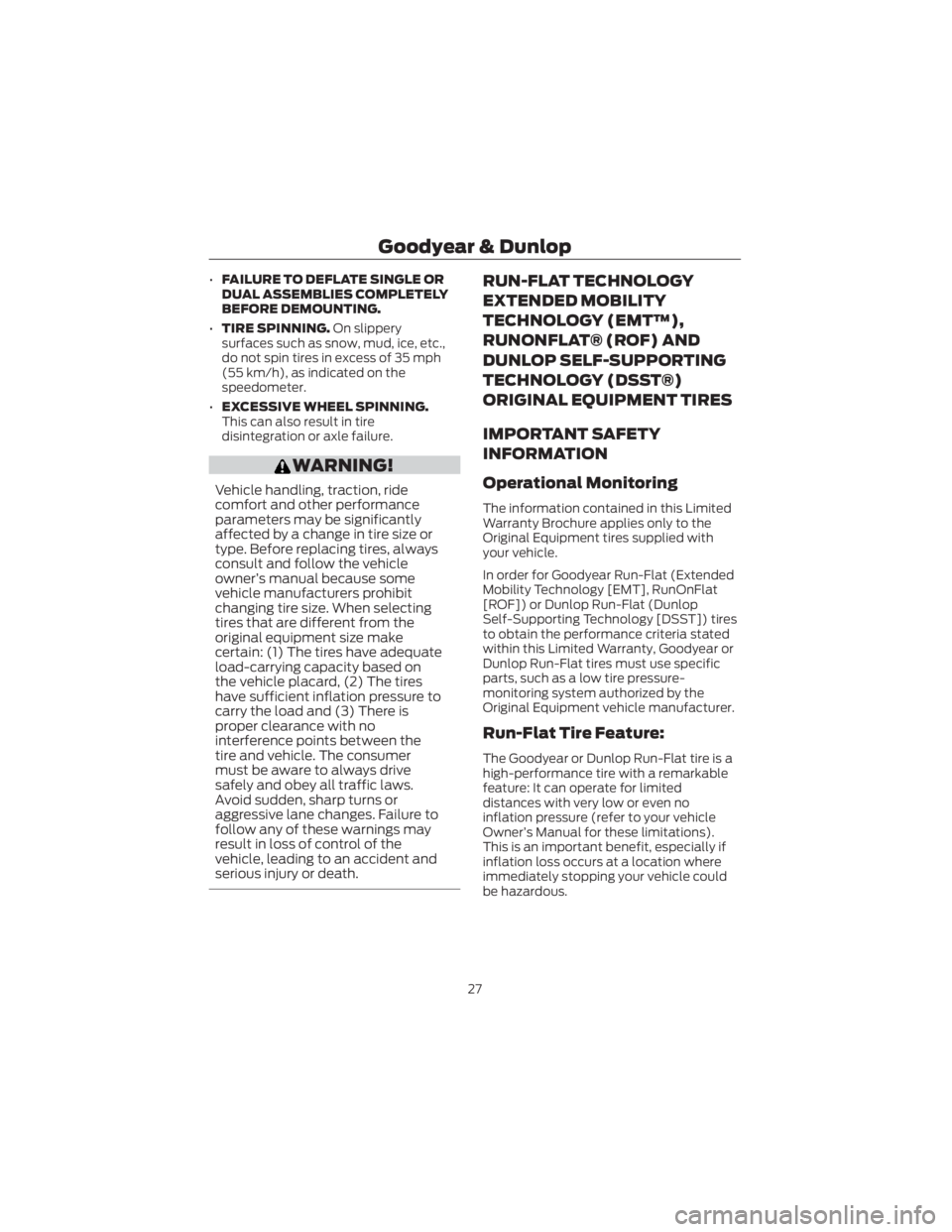
•FAILURE TO DEFLATE SINGLE OR
DUAL ASSEMBLIES COMPLETELY
BEFORE DEMOUNTING.
• TIRE SPINNING. On slippery
surfaces such as snow, mud, ice, etc.,
do not spin tires in excess of 35 mph
(55 km/h), as indicated on the
speedometer.
• EXCESSIVE WHEEL SPINNING.
This can also result in tire
disintegration or axle failure.
WARNING!
Vehicle handling, traction, ride
comfort and other performance
parameters may be significantly
affected by a change in tire size or
type. Before replacing tires, always
consult and follow the vehicle
owner’s manual because some
vehicle manufacturers prohibit
changing tire size. When selecting
tires that are different from the
original equipment size make
certain: (1) The tires have adequate
load-carrying capacity based on
the vehicle placard, (2) The tires
have sufficient inflation pressure to
carry the load and (3) There is
proper clearance with no
interference points between the
tire and vehicle. The consumer
must be aware to always drive
safely and obey all traffic laws.
Avoid sudden, sharp turns or
aggressive lane changes. Failure to
follow any of these warnings may
result in loss of control of the
vehicle, leading to an accident and
serious injury or death.
RUN-FLAT TECHNOLOGY
EXTENDED MOBILITY
TECHNOLOGY (EMT™),
RUNONFLAT® (ROF) AND
DUNLOP SELF-SUPPORTING
TECHNOLOGY (DSST®)
ORIGINAL EQUIPMENT TIRES
IMPORTANT SAFETY
INFORMATION
Operational Monitoring
The information contained in this Limited
Warranty Brochure applies only to the
Original Equipment tires supplied with
your vehicle.
In order for Goodyear Run-Flat (Extended
Mobility Technology [EMT], RunOnFlat
[ROF]) or Dunlop Run-Flat (Dunlop
Self-Supporting Technology [DSST]) tires
to obtain the performance criteria stated
within this Limited Warranty, Goodyear or
Dunlop Run-Flat tires must use specific
parts, such as a low tire pressure-
monitoring system authorized by the
Original Equipment vehicle manufacturer.
Run-Flat Tire Feature:
The Goodyear or Dunlop Run-Flat tire is a
high-performance tire with a remarkable
feature: It can operate for limited
distances with very low or even no
inflation pressure (refer to your vehicle
Owner’s Manual for these limitations).
This is an important benefit, especially if
inflation loss occurs at a location where
immediately stopping your vehicle could
be hazardous.
Goodyear & Dunlop
27
Page 61 of 73
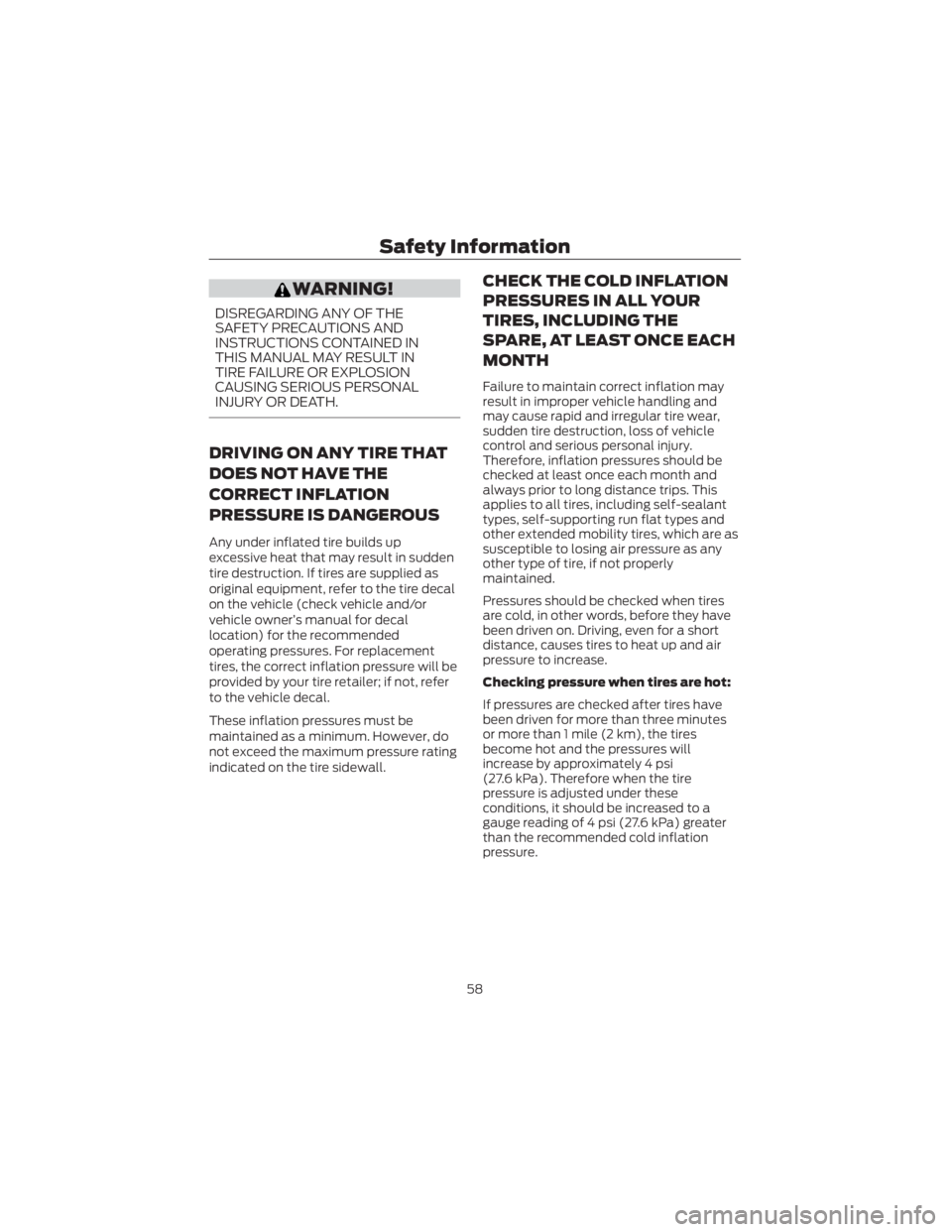
WARNING!
DISREGARDING ANY OF THE
SAFETY PRECAUTIONS AND
INSTRUCTIONS CONTAINED IN
THIS MANUAL MAY RESULT IN
TIRE FAILURE OR EXPLOSION
CAUSING SERIOUS PERSONAL
INJURY OR DEATH.
DRIVING ON ANY TIRE THAT
DOES NOT HAVE THE
CORRECT INFLATION
PRESSURE IS DANGEROUS
Any under inflated tire builds up
excessive heat that may result in sudden
tire destruction. If tires are supplied as
original equipment, refer to the tire decal
on the vehicle (check vehicle and/or
vehicle owner’s manual for decal
location) for the recommended
operating pressures. For replacement
tires, the correct inflation pressure will be
provided by your tire retailer; if not, refer
to the vehicle decal.
These inflation pressures must be
maintained as a minimum. However, do
not exceed the maximum pressure rating
indicated on the tire sidewall.
CHECK THE COLD INFLATION
PRESSURES IN ALL YOUR
TIRES, INCLUDING THE
SPARE, AT LEAST ONCE EACH
MONTH
Failure to maintain correct inflation may
result in improper vehicle handling and
may cause rapid and irregular tire wear,
sudden tire destruction, loss of vehicle
control and serious personal injury.
Therefore, inflation pressures should be
checked at least once each month and
always prior to long distance trips. This
applies to all tires, including self-sealant
types, self-supporting run flat types and
other extended mobility tires, which are as
susceptible to losing air pressure as any
other type of tire, if not properly
maintained.
Pressures should be checked when tires
are cold, in other words, before they have
been driven on. Driving, even for a short
distance, causes tires to heat up and air
pressure to increase.
Checking pressure when tires are hot:
If pressures are checked after tires have
been driven for more than three minutes
or more than 1 mile (2 km), the tires
become hot and the pressures will
increase by approximately 4 psi
(27.6 kPa). Therefore when the tire
pressure is adjusted under these
conditions, it should be increased to a
gauge reading of 4 psi (27.6 kPa) greater
than the recommended cold inflation
pressure.
SafetyInformation
58
Page 62 of 73
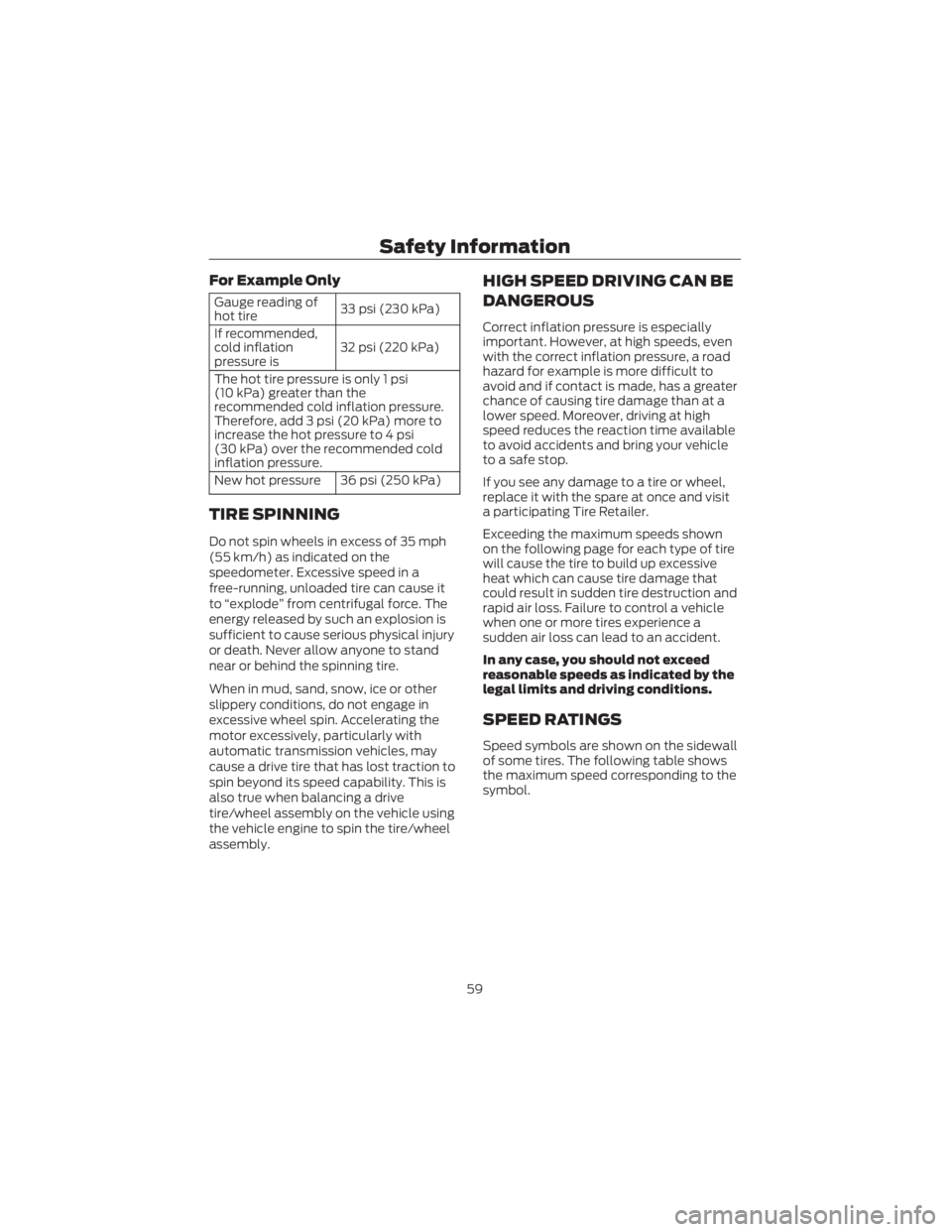
For Example Only
Gauge reading of
hot tire33 psi (230 kPa)
If recommended,
cold inflation
pressure is 32 psi (220 kPa)
The hot tire pressure is only 1 psi
(10 kPa) greater than the
recommended cold inflation pressure.
Therefore, add 3 psi (20 kPa) more to
increase the hot pressure to 4 psi
(30 kPa) over the recommended cold
inflation pressure.
New hot pressure 36 psi (250 kPa)
TIRE SPINNING
Do not spin wheels in excess of 35 mph
(55 km/h) as indicated on the
speedometer. Excessive speed in a
free-running, unloaded tire can cause it
to “explode” from centrifugal force. The
energy released by such an explosion is
sufficient to cause serious physical injury
or death. Never allow anyone to stand
near or behind the spinning tire.
When in mud, sand, snow, ice or other
slippery conditions, do not engage in
excessive wheel spin. Accelerating the
motor excessively, particularly with
automatic transmission vehicles, may
cause a drive tire that has lost traction to
spin beyond its speed capability. This is
also true when balancing a drive
tire/wheel assembly on the vehicle using
the vehicle engine to spin the tire/wheel
assembly.
HIGH SPEED DRIVING CAN BE
DANGEROUS
Correct inflation pressure is especially
important. However, at high speeds, even
with the correct inflation pressure, a road
hazard for example is more difficult to
avoid and if contact is made, has a greater
chance of causing tire damage than at a
lower speed. Moreover, driving at high
speed reduces the reaction time available
to avoid accidents and bring your vehicle
to a safe stop.
If you see any damage to a tire or wheel,
replace it with the spare at once and visit
a participating Tire Retailer.
Exceeding the maximum speeds shown
on the following page for each type of tire
will cause the tire to build up excessive
heat which can cause tire damage that
could result in sudden tire destruction and
rapid air loss. Failure to control a vehicle
when one or more tires experience a
sudden air loss can lead to an accident.
In any case, you should not exceed
reasonable speeds as indicated by the
legal limits and driving conditions.
SPEED RATINGS
Speed symbols are shown on the sidewall
of some tires. The following table shows
the maximum speed corresponding to the
symbol.
Safety Information
59
Page 65 of 73
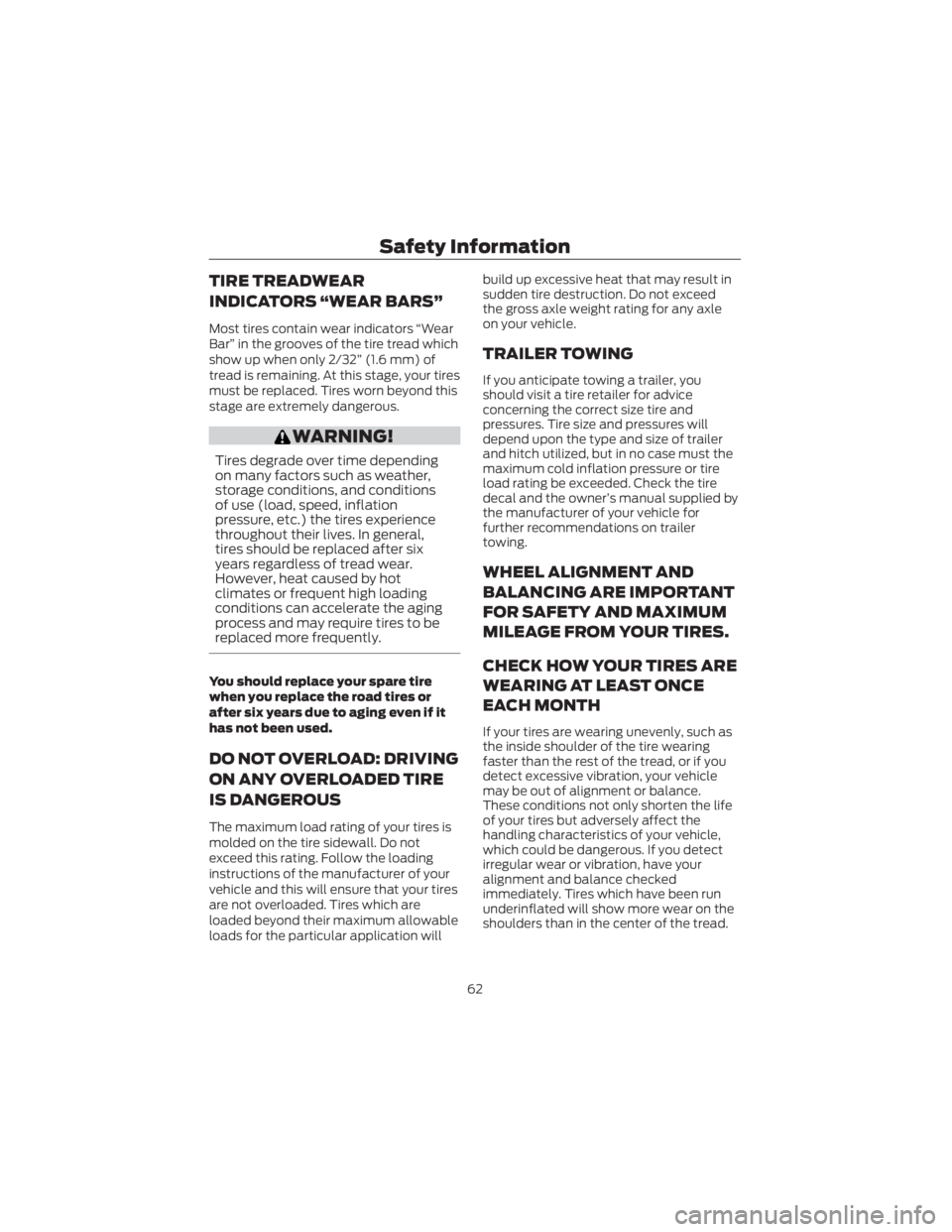
TIRE TREADWEAR
INDICATORS “WEAR BARS”
Most tires contain wear indicators “Wear
Bar” in the grooves of the tire tread which
show up when only 2/32” (1.6 mm) of
tread is remaining. At this stage, your tires
must be replaced. Tires worn beyond this
stage are extremely dangerous.
WARNING!
Tires degrade over time depending
on many factors such as weather,
storage conditions, and conditions
of use (load, speed, inflation
pressure, etc.) the tires experience
throughout their lives. In general,
tires should be replaced after six
years regardless of tread wear.
However, heat caused by hot
climates or frequent high loading
conditions can accelerate the aging
process and may require tires to be
replaced more frequently.
You should replace your spare tire
when you replace the road tires or
after six years due to aging even if it
has not been used.
DO NOT OVERLOAD: DRIVING
ON ANY OVERLOADED TIRE
IS DANGEROUS
The maximum load rating of your tires is
molded on the tire sidewall. Do not
exceed this rating. Follow the loading
instructions of the manufacturer of your
vehicle and this will ensure that your tires
are not overloaded. Tires which are
loaded beyond their maximum allowable
loads for the particular application willbuild up excessive heat that may result in
sudden tire destruction. Do not exceed
the gross axle weight rating for any axle
on your vehicle.
TRAILER TOWING
If you anticipate towing a trailer, you
should visit a tire retailer for advice
concerning the correct size tire and
pressures. Tire size and pressures will
depend upon the type and size of trailer
and hitch utilized, but in no case must the
maximum cold inflation pressure or tire
load rating be exceeded. Check the tire
decal and the owner’s manual supplied by
the manufacturer of your vehicle for
further recommendations on trailer
towing.
WHEEL ALIGNMENT AND
BALANCING ARE IMPORTANT
FOR SAFETY AND MAXIMUM
MILEAGE FROM YOUR TIRES.
CHECK HOW YOUR TIRES ARE
WEARING AT LEAST ONCE
EACH MONTH
If your tires are wearing unevenly, such as
the inside shoulder of the tire wearing
faster than the rest of the tread, or if you
detect excessive vibration, your vehicle
may be out of alignment or balance.
These conditions not only shorten the life
of your tires but adversely affect the
handling characteristics of your vehicle,
which could be dangerous. If you detect
irregular wear or vibration, have your
alignment and balance checked
immediately. Tires which have been run
underinflated will show more wear on the
shoulders than in the center of the tread.
Safety
Information
62
Page 66 of 73
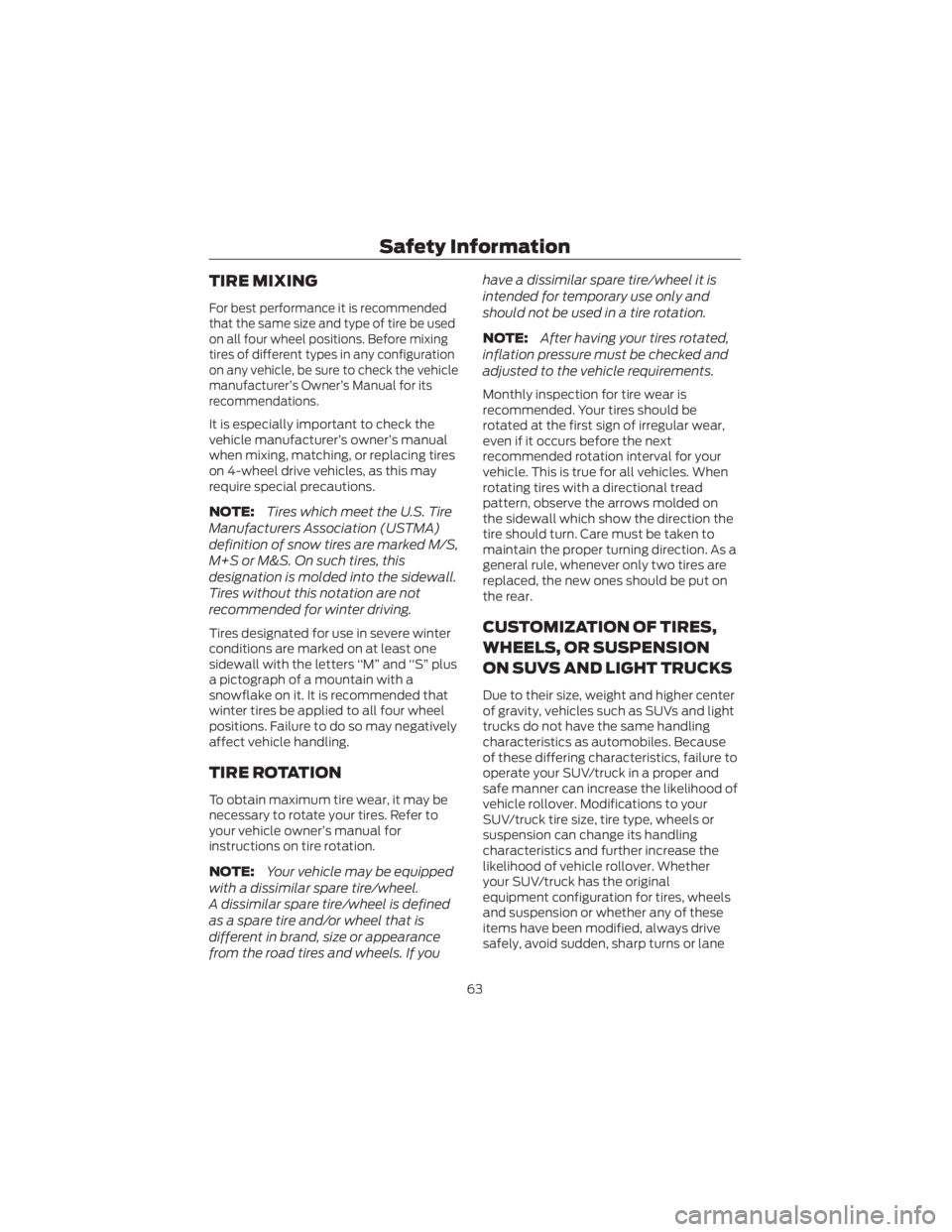
TIRE MIXING
For best performance it is recommended
that the same size and type of tire be used
on all four wheel positions. Before mixing
tires of different types in any configuration
on any vehicle, be sure to check the vehicle
manufacturer’s Owner’s Manual for its
recommendations.
It is especially important to check the
vehicle manufacturer’s owner’s manual
when mixing, matching, or replacing tires
on 4-wheel drive vehicles, as this may
require special precautions.
NOTE:Tires which meet the U.S. Tire
Manufacturers Association (USTMA)
definition of snow tires are marked M/S,
M+S or M&S. On such tires, this
designation is molded into the sidewall.
Tires without this notation are not
recommended for winter driving.
Tires designated for use in severe winter
conditions are marked on at least one
sidewall with the letters ‘‘M” and ‘‘S” plus
a pictograph of a mountain with a
snowflake on it. It is recommended that
winter tires be applied to all four wheel
positions. Failure to do so may negatively
affect vehicle handling.
TIRE ROTATION
To obtain maximum tire wear, it may be
necessary to rotate your tires. Refer to
your vehicle owner’s manual for
instructions on tire rotation.
NOTE: Your vehicle may be equipped
with a dissimilar spare tire/wheel.
A dissimilar spare tire/wheel is defined
as a spare tire and/or wheel that is
different in brand, size or appearance
from the road tires and wheels. If you have a dissimilar spare tire/wheel it is
intended for temporary use only and
should not be used in a tire rotation.
NOTE:
After having your tires rotated,
inflation pressure must be checked and
adjusted to the vehicle requirements.
Monthly inspection for tire wear is
recommended. Your tires should be
rotated at the first sign of irregular wear,
even if it occurs before the next
recommended rotation interval for your
vehicle. This is true for all vehicles. When
rotating tires with a directional tread
pattern, observe the arrows molded on
the sidewall which show the direction the
tire should turn. Care must be taken to
maintain the proper turning direction. As a
general rule, whenever only two tires are
replaced, the new ones should be put on
the rear.
CUSTOMIZATION OF TIRES,
WHEELS, OR SUSPENSION
ON SUVS AND LIGHT TRUCKS
Due to their size, weight and higher center
of gravity, vehicles such as SUVs and light
trucks do not have the same handling
characteristics as automobiles. Because
of these differing characteristics, failure to
operate your SUV/truck in a proper and
safe manner can increase the likelihood of
vehicle rollover. Modifications to your
SUV/truck tire size, tire type, wheels or
suspension can change its handling
characteristics and further increase the
likelihood of vehicle rollover. Whether
your SUV/truck has the original
equipment configuration for tires, wheels
and suspension or whether any of these
items have been modified, always drive
safely, avoid sudden, sharp turns or lane
Safety Information
63
Page 68 of 73
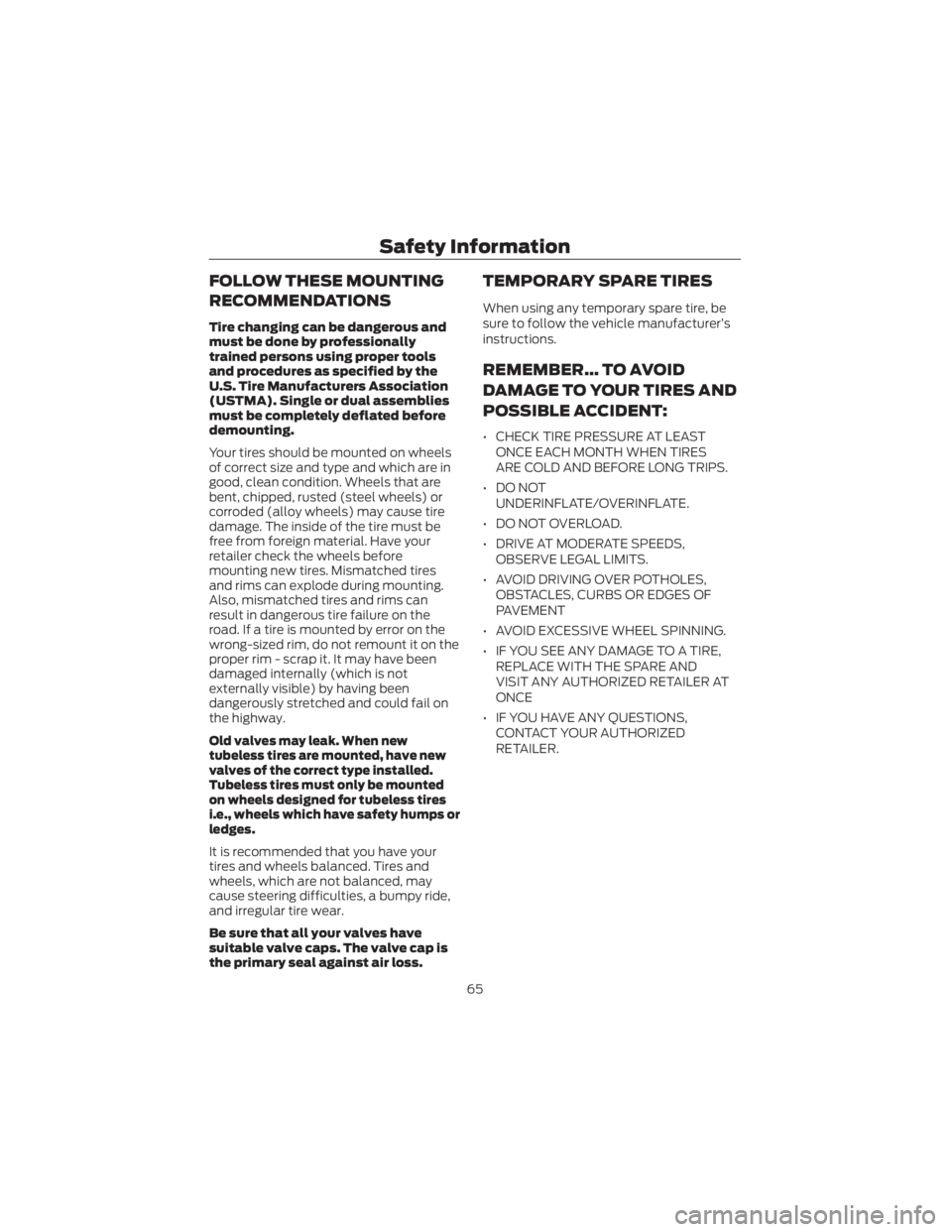
FOLLOW THESE MOUNTING
RECOMMENDATIONS
Tire changing can be dangerous and
must be done by professionally
trained persons using proper tools
and procedures as specified by the
U.S. Tire Manufacturers Association
(USTMA). Single or dual assemblies
must be completely deflated before
demounting.
Your tires should be mounted on wheels
of correct size and type and which are in
good, clean condition. Wheels that are
bent, chipped, rusted (steel wheels) or
corroded (alloy wheels) may cause tire
damage. The inside of the tire must be
free from foreign material. Have your
retailer check the wheels before
mounting new tires. Mismatched tires
and rims can explode during mounting.
Also, mismatched tires and rims can
result in dangerous tire failure on the
road. If a tire is mounted by error on the
wrong-sized rim, do not remount it on the
proper rim - scrap it. It may have been
damaged internally (which is not
externally visible) by having been
dangerously stretched and could fail on
the highway.
Old valves may leak. When new
tubeless tires are mounted, have new
valves of the correct type installed.
Tubeless tires must only be mounted
on wheels designed for tubeless tires
i.e., wheels whichhave safetyhumps or
ledges.
It is recommended that you have your
tires and wheels balanced. Tires and
wheels, which are not balanced, may
cause steering difficulties, a bumpy ride,
and irregular tire wear.
Be sure that all your valves have
suitable valve caps. The valve cap is
the primary seal against air loss.
TEMPORARY SPARE TIRES
When using any temporary spare tire, be
sure to follow the vehicle manufacturer’s
instructions.
REMEMBER... TO AVOID
DAMAGE TO YOUR TIRES AND
POSSIBLE ACCIDENT:
• CHECK TIRE PRESSURE AT LEAST
ONCE EACH MONTH WHEN TIRES
ARE COLD AND BEFORE LONG TRIPS.
•DONOT UNDERINFLATE/OVERINFLATE.
• DO NOT OVERLOAD.
• DRIVE AT MODERATE SPEEDS, OBSERVE LEGAL LIMITS.
• AVOID DRIVING OVER POTHOLES, OBSTACLES, CURBS OR EDGES OF
PAVEMENT
• AVOID EXCESSIVE WHEEL SPINNING.
• IF YOU SEE ANY DAMAGE TO A TIRE, REPLACE WITH THE SPARE AND
VISIT ANY AUTHORIZED RETAILER AT
ONCE
• IF YOU HAVE ANY QUESTIONS, CONTACT YOUR AUTHORIZED
RETAILER.
Safety Information
65